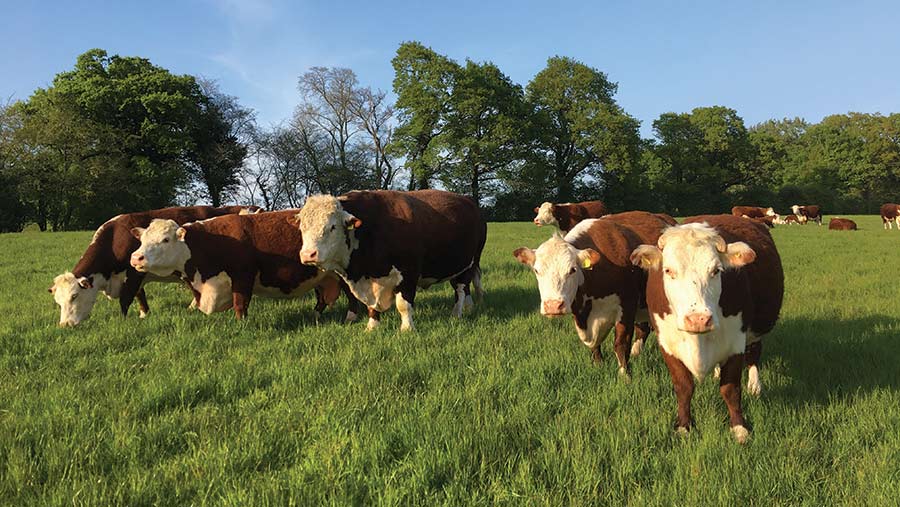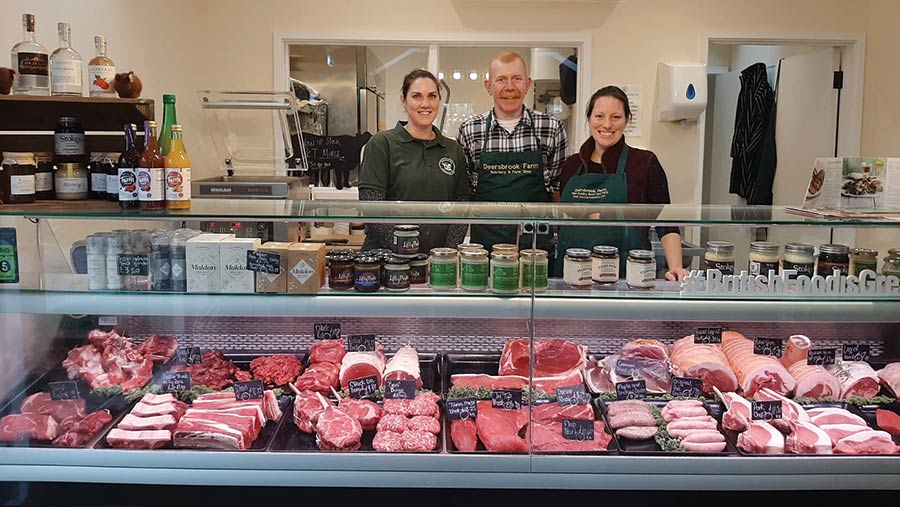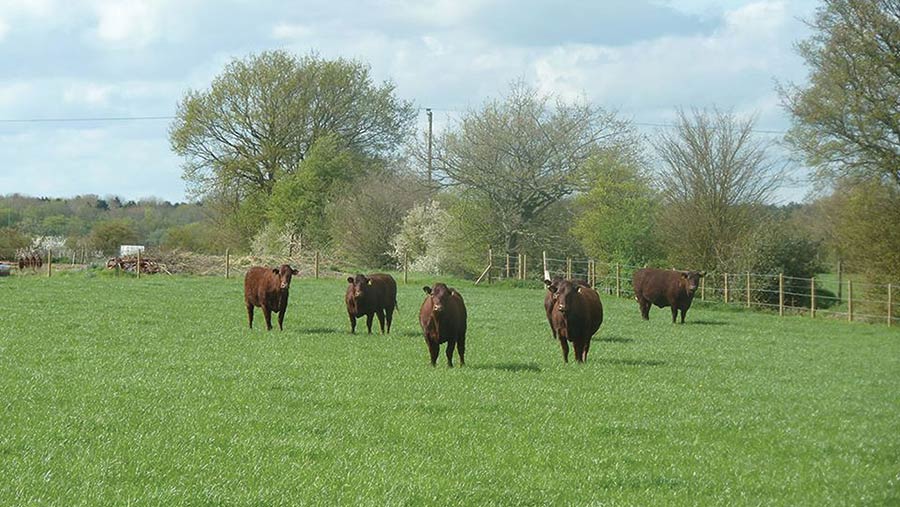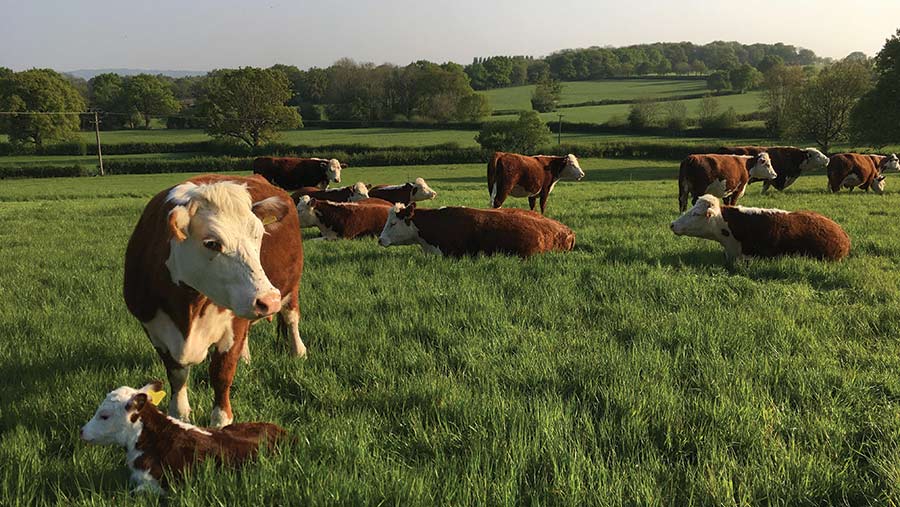Coronavirus: Consumer appetite for grass-fed meat surges

The coronavirus pandemic has rocked food supply chains, with British beef and sheep farmers facing disruption caused by irrational buying in supermarkets and the loss of the food service market.
But, for farmers who can sell directly to the consumer at farm shops and through online delivery, many have seen business increase, as shoppers turn to local produce in response to empty supermarket shelves and the most vulnerable being forced to self-isolate during the health crisis.
This eagerness to buy British meat, produced locally, is proving a big boost for the Pasture-Fed Livestock Association (PFLA), a group of UK farmers passionate about raising animals purely on grass, while improving biodiversity and capturing carbon on their land.
See also: Map: Find a farm shop near you
“It is an exciting experience to buy something direct and it is way more fun and rewarding than going to a supermarket,” says Jimmy Woodrow, head of consumer and supply chain at the PFLA.
“I hope that is what will make people continue these new relationships they have built up.”
Established in 2009, the association has grown to 585 members, 80% of whom are farmers with the rest being butchers and independent retailers. Its main aim is to increase the supply and market for 100% grass-fed meat.
Mr Woodrow is confident that, despite the inevitable dip in sales once the pandemic subsides and supply chains steady, new customers will see the benefits of continuing to buy this produce locally.
“I think there will be a new heightened ‘normal’ of sales in these channels,” he says.
“There is no loyalty with the supermarket and people should be saying ‘we were together in the bad times, so we are together in the good times’ – not least when you taste what you are eating. It is a different product.”
Consumer awareness
With debates raging in the news and on social media about climate change and red meat consumption, the PFLA is helping its members market their meat, by educating consumers about the low-input methods used to produce it as well as highlighting the nutritional benefits.
The association points to increasing scientific evidence, including work carried out at the University of Newcastle, that meat and milk from animals that have only ever eaten grass and pasture is different in nutritional quality – lower in saturated fat, a much healthier ratio of Omega-3 to Omega-6 fatty acids, and more vitamins and minerals.
“The issue that we’ve always faced is how do we get more people to become aware of what we are doing, because generally when they do, it just makes sense,” Mr Woodrow says.
“The role for me is about creating an environment and a structure within which enterprising farmers can succeed.”
This includes plans to create an online livestock marketplace where certified PFLA farmers can trade animals, a project that has been accelerated because of the pandemic.
“Farmers that have predominantly had restaurants as their sale outlet have struggled, so we are trying to divert those animals into other channels,” he adds.
“You’ve got finishing farms who can’t access store cattle and then you’ve got suckler herds who don’t have an outlet for their store cattle, so we are trying to connect some of these dots.”
Join the club
Membership costs £100/year and gives access to a forum where farmers, butchers and retailers can connect and share ideas and advice.
Certification costs about £300/year, which allows farmers to use the Pasture for Life (PFL) certification mark, which tells consumers the meat is 100% grass-fed.
Butchers and retailers can also be certified, which gives them access to joint marketing initiatives and promotional schemes.
Climate research group
A research group of Pasture-Fed Livestock Association (PFLA) members has been formed to look at climate change, tasked with collecting data on the positive work farmers are doing around carbon sequestration and biodiversity.
Peer-reviewed data is crucial in helping to prove that some livestock farmers are part of the solution to the climate crisis, not part of the problem, says Mr Woodrow.
“We are looking to take more data on all our farms so that we can start proving we are potentially carbon neutral already,” he explains.
“I want to get as many of our farms recording data so we can present something that is representative of the PFLA. But even on a single farm, if you have data to show your customers, I think that is also powerful.
“We have a very motivated and energised membership who are looking to prove these points.”
Case study: Deersbrook Farm, Essex
Anna Blumfield, a Pasture for Life (PFL)-certified farmer based near Braintree in Essex, sells grass-fed beef in her farm shop and butchery, which opened in December 2018.
She has 150 Sussex cows and five bulls and explains that the native breed is perfect for the 100% grass diet.

“The breeding is really important; they absolutely thrive on pasture alone.
“A lot of the other breeds, the continentals, need that grain to finish properly, whereas the native breeds finish beautifully on grass.”
They take longer to finish – between 24 and 30 months – but the farmer says it is worth it to unlock the full flavour and potential of the meat.
“They may take a little longer, which is why some people don’t continue with it [a 100% grass-fed system],” she explains.
“There is also increased cost on the slaughter for animals over 30 months, for testing and removing the spine.
“You do get the extra cost, so you add that slight premium on for the customer.”
Mrs Blumfield says that her PFL-certified beef carcasses achieve an 8% premium.
Environment
But there are other benefits of the system, she adds.
“It makes sense because of the environment; we want the soil to be as healthy as it can be, because better soil means better food for the cattle and their digestive system.
“That fantastic nutrition and energy passes on through the meat to the consumer, it follows on the whole path to produce the highest-quality meat.”

© Anna Blumfield
Sales have quadrupled since the coronavirus pandemic, with four staff working flat out in the shop to keep up with demand.
“People are eating local and seeing the benefits of it and the farmers who produce it,” says Mrs Blumfield.
“My husband, Phil, was out on his tractor and people were waving at him as he went down the high street. Normally, he might get tooted or cursed at.”
Pollution
The farm sits under a flight path to Stansted Airport and, since the lockdown began, with nearly all flights grounded, Mrs Blumfield has noticed the difference in air quality, which makes her question whether farmers are shouldering an unfair amount of blame for the climate crisis.
“I really hope there is research through organisations such as Greenpeace and the Soil Association looking at the benefit to the air and soil condition in the current circumstances, so people realise how we can help the global climate change situation and not to reopen all the airports as they were, and to restrict traffic levels.”
Regional approach to marketing
The Pasture-Fed Livestock Association (PFLA) is encouraged by the emergence of regional groups within the association, with farmers and butchers in the same area talking among themselves.
Acting chairman Fidelity Weston, who is a beef and sheep farmer in Sevenoaks, Kent, says this engagement with the butchers, who are the link to the consumer at the counter, could be the start of strong, local supply chains that are mirrored across the country.
“There is enough of us now from Kent, Surrey and Sussex, who want to start telling butchers why they should buy PFL [Pasture for Life] meat.”
There are more than 40 butchers signed up to the PFLA and the association wants to empower its farmers to speak to others, which will help grow the market for 100% grass-fed beef.
“Farmers are busy enough as it is and we end up being masters of so many different tasks, but we hope we can give members the confidence and right information to develop these relationships.”
A key part of this is explaining why the premium on the meat is worth paying, Mrs Weston says.

“To understand the health and environmental benefits, as well as the high animal welfare standards, we need to get these people out on to our farms so they can see.”
Mr Woodrow says that, while regional groups are no silver bullet, maintaining the strong sense of community that has carried the association through its first 10 years is vital for future success.
“On our forum, for example, when ideas are being discussed, most people know each other, which means they talk freely.
“It is far easier to get your neighbour involved in the PFLA than it is for someone centrally. It makes sense for local farmers to talk and trade, and that is going to cause a growth of certification and membership.
“It is an exciting time. It feels like there is real purpose behind what we are doing.”
